1. What Creates the Entry Point Disconnect?
One aspect that is basic to all the newcomer pathways to adulthood is a disconnect between ‘I’ and ‘uchi’. We now need to explore exactly what creates this disconnect in the first place. In Module 6.1 you saw how ‘I’ and ‘uchi’ represent different vantagepoints for the speaker in English versus Japanese communication situations. The vantagepoint for the English speaker is the individual ‘I’, while the vantagepoint for the Japanese speaker is ‘uchi’. This means that the Japanese speaker always sees herself as being within an ‘uchi’ group. The Japanese speaker can identify self within a variety of ‘uchi’ contextual perspectives. As a result,‘uchi’ can be variously translated as ‘I’, ‘me’, ‘my group’ ‘mine’; or ‘we’, ‘us’, ‘our group’, or ‘ours’. Yet, even when ‘uchi’ is translated as an individual ‘I’ or ‘me’ the ‘uchi’ group is still implicit in the spoken context.
‘Uchi’ thus places an individual within a social context. One’s basic uchi is the family/household; while other uchi memberships include school, workplace, dorm, or other organizations. Each of the newcomers participated in one (or more) of these uchi contexts. The ‘I’, however, centers on the individual, without explicit focus on the social context of family, school, or workplace. This difference in perspectives sets the stage for an entry scenario that produces the two perspectives shown in the Peter case in Part 1, in which Peter and Okaasan each view the scenes they share together quite differently. We will now explore this type of entry scenario more deeply, to show first how a disconnect is created, and then how the newcomers can get beyond this disconnect. We begin by examining the concerns expressed by the newcomers and their hosts as the newcomers first enter their situations.

Matt’s group-head Otsuka’s viewpoint: I hope Matt tries to fit into our company, and that he keeps on learning Japanese.
Host Concerns:
The hosts also had concerns that were markedly similar across all the newcomer situations. They wanted their newcomer(s) to participate fully in the activities and duties of their company, school, dorm, or family. Each hoped the newcomer would try to fit in and figure out their ways of doing things. “Fitting in” had its own expectations: the newcomer should observe carefully how things were done, and then follow these ways, rather than disrupting things by asking many questions.
The hosts anticipated that the newcomers would adapt themselves to their new environment, rather than trying to change things in the environment to fit them (like the furniture in the office, or work schedules). Most important of all was establishing relationships, and the most crucial relationship was with one’s immediate supervisor (the group head, senpai, mother-in-law, or team teacher). In short, the hosts wanted the newcomers to become “part of” their family, school, dorm, or company, and they had very specific ideas about how this should be accomplished.

Matt’s viewpoint: I’m looking forward to working on 3-D computer simulation. I’m really pleased that I’ve been hired to do what I really like.
Newcomer Concerns:
The newcomers all had similar concerns no matter what their situation was. They wanted to perform well in their new situations and use their skills effectively. Each wanted a job (or host family, dorm, team teaching situation) that would “fit” them (meaning it fit their individual skills, personalities, career goals, and so forth). They expected to be given clear guidelines about how to make this “fit”. They assumed there would be an explanation of their tasks, (e.g., a job description), directions on how to do their tasks, and feedback on how they were doing.
In short, the newcomers focused on themselves as individuals, and on how well their new situation “fit” their skills and interests, rather than seeing themselves as part of a family, school, dorm, or company. Most placed value on personal freedom, which included developing their own areas of competence (such as teaching their own courses). They also wanted to develop a life and friends outside their situation, not connected with their hosts. In fact, some newcomers had come to Japan precisely to expand their personal freedom.
These two sets of expectations are portrayed in the figure below:
Figure 1: The Entry Point Disconnect
What is striking about these two sets of concerns is the degree of disconnect between them. The newcomers appear to have few ideas of “fitting in”, participating, or establishing relationships within an uchi context. In fact, they seem to have little awareness of uchi at all. The hosts, on their part, are unaware of any need to specify such things as job guidelines, or to spell out any of the particular “ways” they expect the newcomers to figure out and follow. Nor do they expect to adapt things to “fit” the newcomers. In fact, the hosts seem unaware of the ‘I’ focus that is fueling the newcomers’ demands for directions and guidelines. They apparently have no idea that the newcomers want to establish their own social identities, and that in order to do this they need to know what is required of them in this new situation.
But why does each side fail almost entirely to grasp the perspectives of the other? And, most importantly, if there is so little overlap between hosts and newcomers, how have so many of the newcomers managed to overcome this disconnect and progressed on the pathway to ‘uchi’?
2. ‘I’ and ‘Uchi’ as Attribute and Frame
The differing expectations of ‘I’ and ‘uchi’ vantage-points portrayed in Figure 1 above can also be related to the anthropologist Nakane Chie’s distinctions between ‘frame’ (ba) and ‘attribute’ (shikaku) in Figure 2 below. Nakane points out that Japanese individuals tend to identify themselves by frame: “I belong to S company”, while a U.S. employee tends to stress attributes such as individual skills: “I’m a software designer.” Can you see how Nakane’s distinctions in Figure 2 also fit the differing expectations of the hosts and newcomers in Figure 1 above?
Figure 2
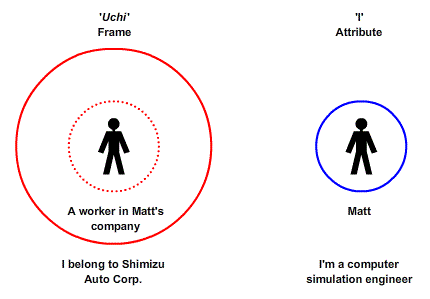
Figure 3 below shows how frame and attribute are also the basis for defining relationships between oneself and others. Being in the same work-group (or ‘uchi’ frame) identifies Matt and his co-workers as being in the same social “spot”. This shared spot means they have the closest relationships in the company. The work-group members further expand their relationships through sharing in a nesting series of ‘uchi’ frames—their section, division, and the entire company—each of which expands the ‘we’ focus of the work-group frame.
In his U.S. company job Matt formed relationships between himself and others (‘I’ and ‘you’) on the basis of attribute similarities, such as professional skills. Matt regarded those in his own field—other computer simulation engineers—as most similar to him, even if they weren’t working in his company. This means that attribute-based relationships transcended group boundaries. Matt commonly identified more closely with others in the same professional field with similar skills, than with those inside his company with whom he shared no attributes.
Notice that frame distinctions in Fig. 3 are defined solely on the basis of shared social space—Matt and his co-workers occupy the same social “spot”. Attribute distinctions are based solely on individually-defined attributes, which can be professional skills, or other individually-defined abilities or traits.
Figure 3
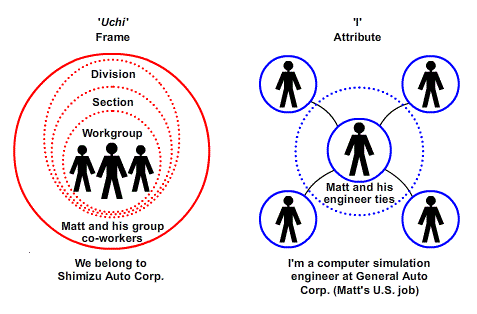
These distinctions between frame and attribute can now help us understand the disconnect that occurred between the initial expectations of the newcomers and those of their hosts. All the newcomers entered situations that were regarded as ‘uchi’ frames by their hosts. These ‘uchi’ frames include all the homestay families, along with the family of the newcomer wife Devita; Carlos’ university dorm, along with the university itself; Abby’s junior high school, the university Prof. Witherspoon is visiting, Matt’s auto company, and Ms. Elainius’ branch company. Thus, all the newcomers entered situations that involved frame-based (‘uchi’) distinctions. Yet all of the newcomers came from societies that prioritized attribute-based (‘I’) distinctions.
Figures 2 and 3 show how these distinctions would lead ‘I’-oriented and ‘uchi’-oriented newcomers to establish their social identities differently when entering new situations. Newcomers entering a frame-based organization are placed within a frame when they arrive. This gives them a social place that is understood by everyone, and this frame establishes their initial social identities. What the newcomers must do next is begin to fit themselves into their frames. Since relationships are part of the frame, one establishes relationships by fitting oneself into them as well. This means that individuals must adjust to fit into the existing setting.
Attribute-based (‘I’-oriented) newcomers arrive with different expectations about the identity process. It is up to them, as individuals, to establish their own social identities, which they do through communicating their attributes. For the ‘I’/attribute newcomers it is important to figure out what is required of them in each new situation. They can then respond by manifesting the appropriate skills and attributes—by “putting their best foot forward”. For these newcomers, social identity must be negotiated in each new situation, and this is managed largely through manifesting the attributes they judge to be appropriate. The newcomers expect to negotiate their contributions to each new relationship. They see themselves as creating, rather than fitting into, their relationships. In other words, they feel the setting should adjust to make the most of what each new person has to offer.
3. Beyond Attribute and Frame: Individual and Society
These attribute and frame distinctions have one major drawback. They can’t help us answer a very important question: how have so many of these newcomers managed to overcome the initial disconnect portrayed above, so they could progress along the pathway to ‘uchi’?
The problem is that attribute and frame represent the expectations of newcomers and hosts as polar opposites. But even though ‘I’ and ‘uchi’ represent polarities, there must be a way to connect these polarities as well. This relationship between the apparent polarities is crucial for a very practical reason: it provides the basis for the cultural child to navigate to adulthood that is the focus of this program. The relationship between ‘I’ and ‘uchi’ is what the stepping stone pathway between ‘I’ and ‘uchi’ represents. It is this pathway—and this relationship—that a newcomer must navigate in order to reach adulthood. Without this relationship there can be no way for the cultural child to grow up.
To understand how the pathway really works we need to relate ‘I’ and ‘uchi’ more broadly beyond attribute and frame, to the individual and society. This will also allow us to move beyond the specific scene of newcomers to Japan, since the individual and society are aspects of social life that are fundamental in every society. A good way to get at the relationship between the individual and society is to look at the situation of a newborn baby.

As a newcomer, the baby resembles the newcomers to Japan in certain ways. But rather than being a “cultural child”, the baby is a real child, who enters the world physically undeveloped and very helpless. Socially the baby is a “blank slate”—since it doesn’t yet have a social world, or language capabilities. This makes a baby the ultimate newcomer—entirely dependent on its caregivers to nurture it and gradually bring it into their social world.
The process by which the newborn baby acquires its social identity, in a sense, parallels the process of the newcomers’ pathway to adulthood, in this program. Yet precisely because the baby is unformed, it doesn’t encounter the kind of disconnect the newcomers experienced when they entered their new situations as already formed adults. In fact, each baby—through the efforts of its caretakers—exhibits impressive abilities to adapt to its new social world. Somehow each baby manages a kind of miracle—a transformation—from a blank slate into a real presence in its family, with such strong ties that it will be hugely missed if something happens to it. Moreover, a baby can manage this adaptive miracle in whatever society it is born (or even adopted) into! Yet the amazing transformation of the baby into a social being is almost entirely taken for granted everywhere, since it is the essence of “what everyone knows but no one can tell you”.
But what if you were a “fly on the wall” who could see how the unformed baby—through its caregivers—manages the transition to become a participating member of its new family? Could you then discover how the baby’s learning transformation might also help the newcomers to overcome the initial disconnect portrayed above?
Babies’ learning in two family environments
To get at the baby’s learning process we need to be able to glimpse how family members actually communicate the basics of their baby’s new social identity as they interact with the baby. Each family has expectations for how its baby will “fit into” the family (just as the newcomers’ hosts had expectations for how they would fit into their new situations). But where can we find real-life examples that show these expectations and how the babies respond to them? Where else but YouTube which has thousands of videos recorded by families world-wide that allow us to glimpse how their babies learned their new social identities!
As examples, we selected two families from the Japanese and English sections of YouTube: The Kohlhoff family from the US, and the Kimura family from Japan. Each family has three small children, and each recorded numerous everyday interactions from the their birth of their children onwards. From these video collections, we selected three sets of clips that reveal the emerging stages of each family’s relationship with its baby. Take a look at each set of clips below, then think over the question that follows each set.
Family Members in the Two Video Sets
Kimura Family - from Aomori Prefecture, northern Japan
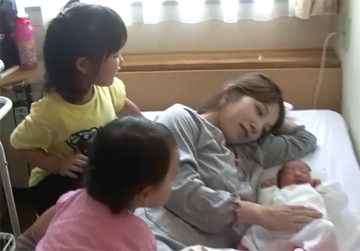
Father (usual videographer)
Mother
Ena—oldest daughter
Reina—second daughter
Shina—new baby daughter
Kohlhoff Family - from Minneapolis, northern Midwest, USA

Father (usual videographer)
Mother
Henry—oldest son
Miller—new baby son
(1) Video Set 1. First meeting of siblings with the new baby. Each video portrays a similar situation: older brother (or sisters) enter a hospital room to meet the new baby. But the focus on how the siblings meet the new baby is different in each video.
Question: Can you pinpoint this difference in focus?
Kohlhoff family: (1a) The Meeting of the Brothers
Kimura family: (1b) The Gathering of the Three Sisters
(2) Video Set 2. Bringing baby home: Early family interactions. The next set of videos focuses on family interactions with the new baby right after it is brought home from the hospital.
Question: How does each family begin to nurture—and get to know—this tiny stranger, and who are the main family members involved in the process?
Kohlhoff family: (2a) Irish Lullaby
Kimura family: (2b) Older sister feeds milk to new baby
(3) Video Set 3. Baby’s beginning responses to family interactions The babies are now beginning to sit up and respond to the interactions of their family members.
Question: Who is eliciting the baby’s responses in each family and what does this show about the family relationships?
Kimura family: (3a) Three sisters Playing together
Kohlhoff family: (3b) Miller Giggling in his seat
(4) Video Set 4. Getting Baby to Bed We will now fast-forward several months and look at how (and where) bedtime occurs for the baby in each family. The focus of the Kohlhoff video is on a younger Henry who sleeps all by himself in his crib in his own room. The second video shows Shina, who sleeps with her entire family, and who is now insisting that she doesn’t want to go to sleep.
Question: How do sleeping arrangements contribute to the formation of each baby (Henry and Shina) as an individual, along with their relations to the rest of the family?
Kohlhoff family: (4a) Henry can shoot a three
Kimura family: (4b) Youngest sister refuses to go to sleep
Summary of expectations for babies in the two families: Even these few short videos clearly show that the Kimura and Kohlhoff families have different expectations for their babies. In fact, each family has different expecations for how their caregiving will mesh with the baby’s learning process, which is exemplified in the different sleeping arrangements for Henry and Shina that are the focus for bothe families in Video 4. Henry sleeps alone in a crib in a large bedroom because the Kohlhoffs are trying to assist him in becoming an individual who can be on their own. In contrast, everyone in the Kimura family is trying to assist the baby to adjust to a social frame where everyone goes to bed at the same time and sleeps together.
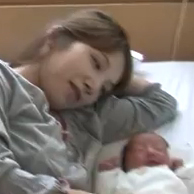
Kimura Family: Starting with the first video in which the Kimura siblings meet the new baby in the hospital, all of the family videos focus on the process of creating the social frame spelled out initially in the “gathering together” of three sisters (Video 1). In fact, the older sisters have a major role in bringing the new baby into the family social frame (uchi), as shown in Videos 2 & 3. Video 3 shows the actual process of how this happens, as Shina participates for the first time in a game with her sisters, rather than passively watching. Shina’s situation within uchi is also spelled out in the family sleeping arrangements, in which the entire family sleeps in one room, with all three siblings sleeping in the same bed with mother. Shina hasn’t yet learned that she is supposed to adapt to others in uchi (for example, at bedtime). But her older sisters have already learned to adapt to the new uchi created by her arrival.
Shina’s parents give much less overt guidance to their children than the Kohlhoffs do, expecting even the baby to figure out how to do things (like walk and play games) on her own. Nakane’s discussion of “frame” fits this family, as illustrated by their sleeping arrangements. Yet Ena, the oldest sister, illustrates how these sisters are also growing up to be individuals within uchi.

Kohlhoff Family: Starting with the first video, when Henry meet his new brother in the hospital, this family’s videos all focus on developing each child into an independent individual. This may not be immediately obvious because it is accomplished primarily through the parents’ instruction. The parents focus on helping each child to develop and learn through their guidance and instruction, and each child is treated as having a unique social identity, different from that of any other sibling. In Video 1 the Kohlhoff parents adapt the situation of the new baby to “fit” Henry, by making him feel like the center of attention, so that he can adapt appropriately to the baby’s arrival. Mother also guides Henry (Video 2) when he is holding the new baby. She is also the primary facilitator for her child’s learning in Video 3 when she engages Miller, and gets him to respond, in much the same way that the Kimura siblings engaged Shina. Henry’s sleeping arrangement in a crib in his own room also shows his parents’ focus on his development as an independent individual.
Nakane’s discussion of “attribute” fits this family, since many videos show their children acquiring personal skills, including Henry singing at an early age, doing impersonations, and making three point baskets from his crib (Video 4). Yet Henry’s attentiveness to Miller in Video 2, illustrates that the social frame is present for the Kohlhoff children too. But they are learning to see this social frame from their individual vantage points (in a family, that for them, is created and sustained by its individual members).
By this point you may have noticed ways in which these families’ expectations for their new babies mirror the expectations of the hosts and newcomers in Parts 1 and 2 above. Now take another look at Figure1 below:
Figure 1: The Entry Point Disconnect
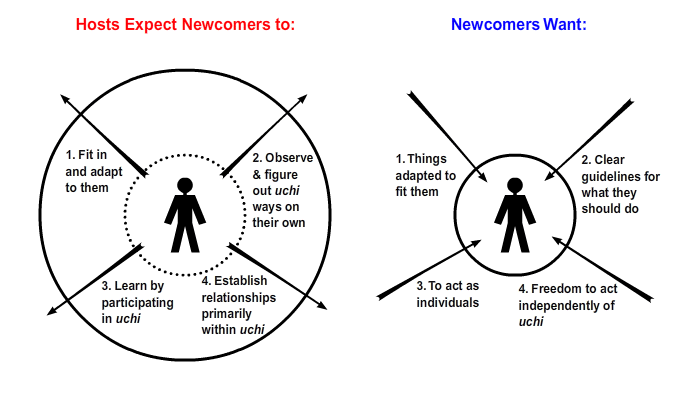
Then compare Figure 1 with each family’s expectations for their new baby below:
Figure 1a: Entry Point Expectations for New Babies
4. Moving Beyond Japan, and ‘I’—‘Uchi’
The babies’ learning processes can now lead us to the very key we need to bridge the initial disconnect faced by the newcomers and their hosts. The key is that every baby—no matter what society it is born into—can move from being a “blank slate” to acquire the basic knowhow of getting along in its new social world. It develops a self-identity in its new world—and the amazing feat of newborn babies is that they can learn to fit into whatever society they happen to enter.
Let’s suppose that the Kohlhoff and Kimura babies were somehow switched at birth, so that Henry ended up in the Kimura family, and Shina with the Kohlhoffs. It is highly likely that Henry would have developed into a big brother as competent and caring toward his younger siblings as Ena, while Shina would be used to sleeping by herself in a crib, and would exhibit many attribute talents, even possibly sinking three-point baskets from her crib.
The videos show us that a two-part process is required for a newborn infant to become fully human: (1) the entry (birth) of a new individual, and (2) the social process through which the baby becomes a participating member of its family’s social world. The individual and social realms of this process are juxtaposed to one another; yet at the same time these two realms are also closely intertwined. A baby enters the world as an unformed individual—like a blank slate. Yet it requires the process of socialization—of being brought into a social world—to become fully human (and you can see how both families are accomplishing this in the videos). And by the same token the social world also requires individuals, since it is anchored in them. In fact, only through individuals, and their relationships with one another, is society visible in the first place.
This two-part process for becoming fully human shows us two fundamental components of human existence: individual human beings and their social worlds. It also reveals that these fundamental components are closely intertwined, in a relationship that is paradoxical. These insights on the relationship between individual and society aren’t new at all. In fact, a well-known sociologist, Emile Durkheim, pointed them out over one hundred years ago. As Durkheim put this:
On the one hand, the individual gets from society the best part of himself, all that gives him a distinct character and a special place among other beings, his intellectual and moral culture. If we should withdraw from men their language, sciences, arts and moral beliefs, they would drop to the rank of animals. So the characteristic attributes of human nature come from society. But on the other hand, society exists and lives only in and through individuals. If the idea of society were extinguished in individual minds and the beliefs, traditions, and aspirations of the group were no longer felt and shared by the individuals, society would die. (1915: 347).
Durkheim is spelling out the same dynamic that the learning process of the newborn baby allows us to see: that the individual and society—at their most fundamental level—are opposites of a special kind: neither can exist without the other. So human beings cannot become fully human without society, and society cannot exist without human beings, since each is deeply involved in bringing about the existence of the other. But how can we link this paradoxically intertwined relationship between individual and society from the newborn babies back to the examples of the newcomers and their hosts? We can start by depicting the intertwining of these components, which will not be static but fluid. The Flash below depicts a loop of the possible permutations of the relationship between individual and society.
Figure 4: Intertwining Forms of the Individual/Society Relationship
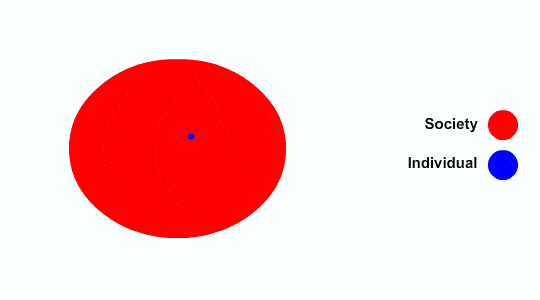
Relating the intertwining forms in Figure 4 to the host/newcomer disconnect
The loop of intertwining forms in Figure 4 shows that the intertwining relationship between individual and society always manifests itself as an encompassment: either one of these components always encompasses the other. Thus the entire loop in Figure 4 depicts two possibilities for the relationship between individual and society: Either: (1) society encompasses the individual, or: (2) the individual encompasses society.
Figure 5. Two Basic Relationships between Individual and Society

Figure 5 shows the same two opposing possibilities for the relationships depicted in the infinite loop of the Figure. 4 Flash above. But this time they are represented without movement, in two freeze-frames from the flash. These freeze-frames now allow you to connect up the two opposing possibilities shown in the flash with relationships in actual societies: Now if you look back at Figure 1 you should be able to glimpse what is behind the disconnect between hosts and newcomers.
- The host (‘uchi’) expectations are produced by an individual/society relationship corresponding to: (1) above, as a social frame that encompasses its individual members, and identifies them as being within that social frame. This perspective centers on the social collectivity, although it can shift temporarily to individuals identified within that frame. The Kimura family fits this perspective.
- The newcomer (‘I’) expectations are produced by a relationship similar to: (2) above, in which the individual operates as a frame, while society is encompassed within this frame. This perspective centers on the individual without any explicit focus on the social context of family, school, or workplace (as explained in Part 1 above). In fact, the individual seems to fill up most of the social frame so that, in effect, these individuals become the equivalent of social frames themselves. The Kohlhoff family fits this perspective.
Now you have completed the groundwork for Key #1.
The fundamental relationship between individual and society developed in depicted in Figures 4 and 5 above is the basis for Key #1. This relationship will now allow you to view the entry point disconnect, and the pathway from ‘I’ to ‘uchi’ from a broader perspective, since other societies—in fact all societies—share the same fundamental intertwining relationships between individual and society. As Durkheim explains above, this is basic to being human.
The next two modules will focus on practical applications to help you learn how to use the new perspective presented in Key #1. These modules also begin to expand the Japanese host and newcomer (‘I’—’uchi’) perspectives into a larger frame of reference that extends beyond Japan.
Key #2 This key focuses on frames, and framing, from the focus on individual/society relationships depicted in Key #1. You will learn (1) how framing is a basic and inescapable part of everyday life, and (2) how the two perspectives on individual/society shown in Figure 5 are fundamental to our everyday processes of framing. The difficulty is that framing is largely taken for granted, so Key #2 assists you in learning to recognize the frames that are crucially important in producing the expectations that fuel our everyday social lives.
Key #3 Once you have learned to “see” frames Key #3 will take you to the next step, of learning to reframe the relationship perspectives shown in Figures 4 and 5a. Key #3 will allow you to navigate the pathway from ‘I’ to ‘uchi’ once more—this time through the focus developed in Keys #1 and #2. You will then be ready to use the three keys not only within, but outside Japan as well. Being a newcomer in situations beyond Japan will be taken up in the final Module 13.3.














